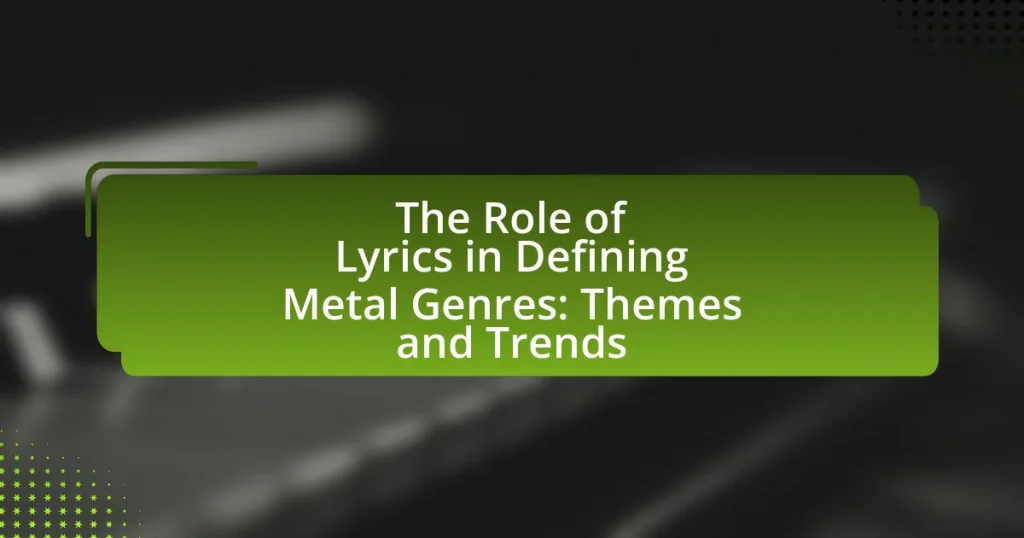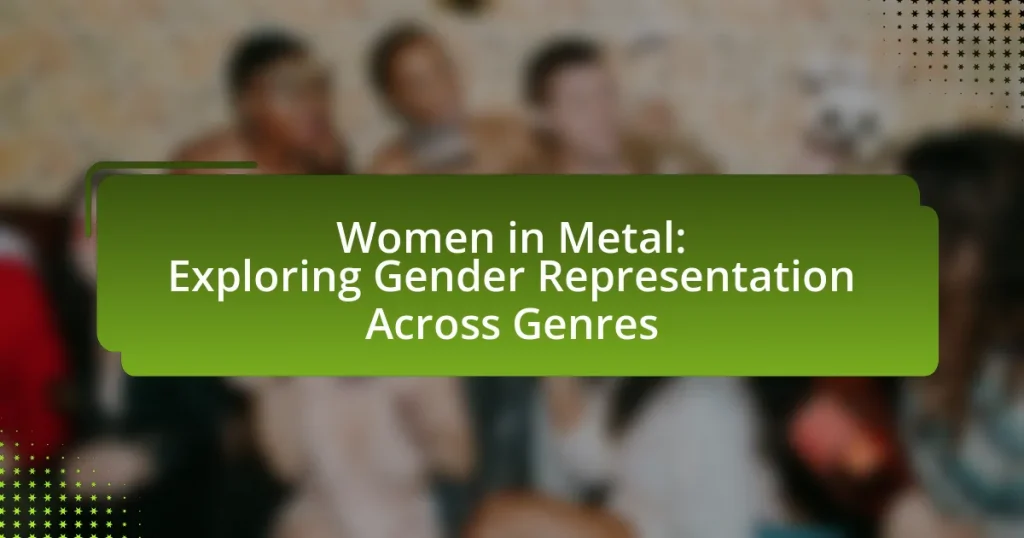Doom Metal is a subgenre of heavy metal known for its slow tempos, heavy riffs, and dark, melancholic atmosphere, originating in the late 1960s and early 1970s, primarily influenced by Black Sabbath. The genre encompasses various subgenres, including Traditional Doom, Stoner Doom, Funeral Doom, Sludge Metal, and Death-Doom, each characterized by unique elements while maintaining core characteristics of heaviness and thematic depth. Pioneering bands such as Black Sabbath, Pentagram, and Saint Vitus have significantly shaped Doom Metal’s identity, which explores themes of despair, mortality, and existentialism. The article delves into the historical influences, defining characteristics, cultural impacts, and global reach of Doom Metal, providing insights into its evolution and significance within the broader metal community.
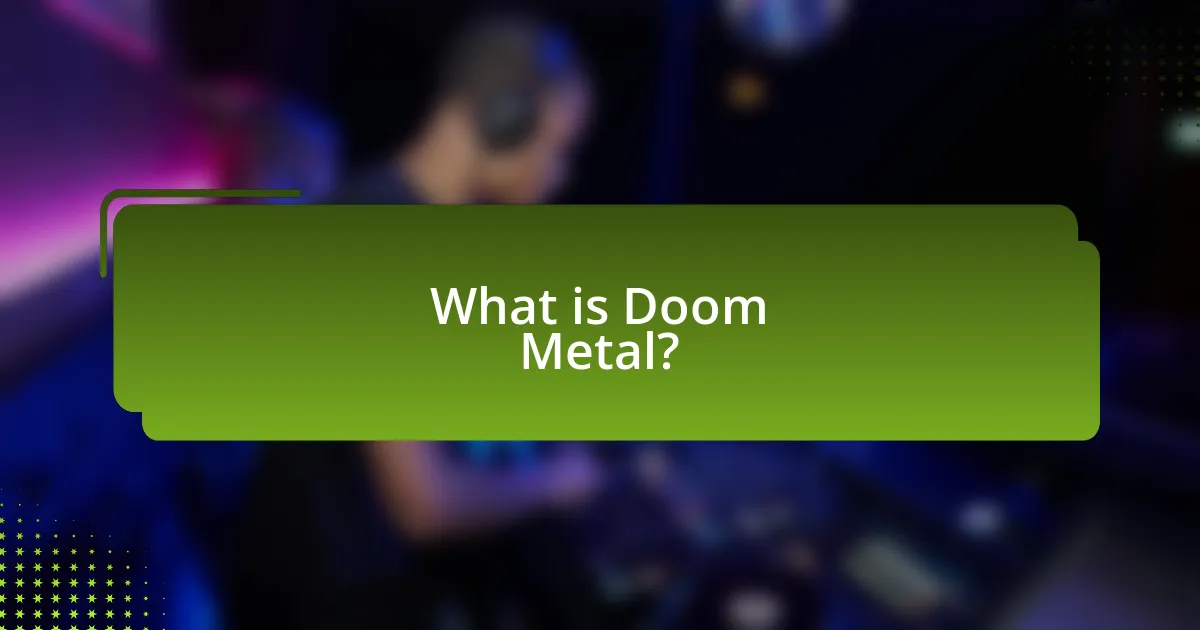
What is Doom Metal?
Doom metal is a subgenre of heavy metal characterized by its slow tempos, heavy riffs, and a generally dark, melancholic atmosphere. Originating in the late 1960s and early 1970s, doom metal draws influence from early heavy metal bands like Black Sabbath, whose music often featured themes of despair and existential dread. The genre typically employs a thick, distorted guitar sound and often includes lyrical content that explores themes of doom, death, and the occult, solidifying its identity within the broader metal landscape.
How did Doom Metal originate?
Doom Metal originated in the late 1960s and early 1970s, primarily influenced by the heavy, slow tempos and dark themes of early Black Sabbath. The genre emerged as a distinct style characterized by its heavy, distorted guitar riffs, somber lyrics, and a focus on atmosphere. Black Sabbath’s self-titled debut album in 1970 is often cited as a foundational work for Doom Metal, establishing the sound and aesthetic that would define the genre. Additionally, bands like Pentagram and Saint Vitus further developed the style in the 1980s, solidifying Doom Metal’s identity within the broader heavy metal landscape.
What are the historical influences on Doom Metal?
Doom Metal is historically influenced by early heavy metal bands, particularly Black Sabbath, whose slow tempos and dark themes laid the groundwork for the genre. The band’s 1970 self-titled debut album featured heavy guitar riffs and a somber atmosphere, which became defining characteristics of Doom Metal. Additionally, the influence of psychedelic rock and blues, particularly from the late 1960s, contributed to the genre’s sound, as bands like Pentagram and Saint Vitus incorporated these elements into their music. The emergence of the genre in the 1980s was also shaped by the underground metal scene, where bands sought to explore themes of despair and existentialism, further solidifying Doom Metal’s identity.
Who are the pioneers of Doom Metal?
The pioneers of Doom Metal are Black Sabbath, Pentagram, and Saint Vitus. Black Sabbath, formed in 1968, is widely regarded as the originator of the genre, with their heavy, slow riffs and dark themes exemplified in songs like “Black Sabbath” and “Iron Man.” Pentagram, emerging in the early 1970s, contributed to the genre’s development with their unique blend of heavy metal and psychedelic rock, particularly evident in their album “Relentless.” Saint Vitus, formed in 1978, further defined the sound of Doom Metal with their slower tempos and heavy, sludgy riffs, as showcased in their self-titled album. These bands laid the groundwork for the Doom Metal genre, influencing countless artists that followed.
What are the defining characteristics of Doom Metal?
Doom Metal is characterized by its slow tempos, heavy guitar riffs, and a generally dark, melancholic atmosphere. This subgenre often features themes of despair, mortality, and existential dread, which are conveyed through both lyrical content and musical composition. The use of down-tuned guitars and a focus on creating a thick, heavy sound further distinguishes Doom Metal from other metal genres. Historically, bands like Black Sabbath, often credited as pioneers of Doom Metal, set the foundation with their heavy sound and lyrical themes, influencing countless artists within the genre.
How does the tempo and rhythm define Doom Metal?
The tempo and rhythm define Doom Metal by establishing its characteristic slow, heavy sound that evokes a sense of despair and heaviness. Typically, Doom Metal features tempos that range from slow to mid-paced, often utilizing down-tuned guitars and extended song structures to create a dense atmosphere. This rhythmic approach emphasizes the weight of the music, allowing for a slow build-up of tension and a focus on the emotional impact of the lyrics. The use of repetitive riffs and a steady, deliberate pace reinforces the genre’s themes of doom and gloom, making the tempo and rhythm essential elements in shaping the overall identity of Doom Metal.
What lyrical themes are commonly found in Doom Metal?
Doom Metal commonly features lyrical themes of despair, existentialism, and the inevitability of death. These themes are often expressed through dark, melancholic imagery and narratives that explore human suffering, loss, and the passage of time. The genre frequently draws on influences from literature and philosophy, with references to concepts such as nihilism and the human condition, reinforcing its focus on bleak and heavy subject matter. Notable bands like Black Sabbath and Candlemass exemplify these themes in their lyrics, which often reflect a sense of hopelessness and introspection.
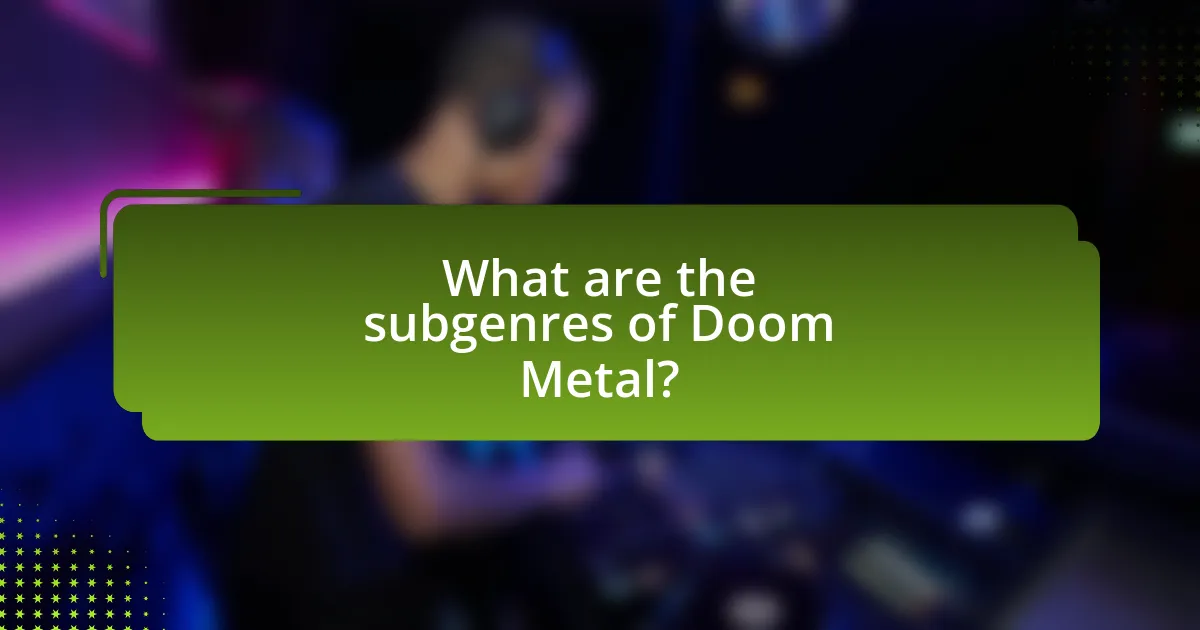
What are the subgenres of Doom Metal?
The subgenres of Doom Metal include Traditional Doom, Stoner Doom, Funeral Doom, Sludge Metal, and Death-Doom. Traditional Doom is characterized by its slow tempos and heavy riffs, often influenced by Black Sabbath. Stoner Doom incorporates elements of psychedelic rock and is known for its groovy sound. Funeral Doom is marked by its extremely slow pace and melancholic atmosphere, often featuring deep growls and atmospheric elements. Sludge Metal blends Doom with elements of Hardcore Punk and Southern Rock, creating a heavier sound. Death-Doom combines the heaviness of Doom Metal with the growls and faster tempos of Death Metal. Each subgenre maintains the core characteristics of Doom while introducing unique elements that differentiate them.
How does Traditional Doom Metal differ from other subgenres?
Traditional Doom Metal is characterized by its slow tempos, heavy guitar riffs, and a focus on melancholic themes, setting it apart from other metal subgenres that often emphasize speed or aggression. Unlike Thrash Metal, which features fast-paced rhythms and aggressive vocals, Traditional Doom Metal maintains a more somber and reflective atmosphere, often drawing influence from early Black Sabbath. Additionally, while genres like Death Metal prioritize technical complexity and harsh vocals, Traditional Doom Metal typically employs clean, melodic singing, enhancing its emotional depth. This distinct combination of elements solidifies Traditional Doom Metal’s unique identity within the broader metal landscape.
What bands exemplify Traditional Doom Metal?
Black Sabbath, Pentagram, and Candlemass exemplify Traditional Doom Metal. Black Sabbath, often credited as the pioneers of the genre, released their self-titled debut album in 1970, which featured heavy, slow riffs and dark themes that defined the sound of doom metal. Pentagram, formed in the early 1970s, is known for their influential album “Relentless,” which further established the genre’s characteristics. Candlemass, emerging in the 1980s, solidified the style with their album “Epicus Doomicus Metallicus,” which is frequently cited as a classic in Traditional Doom Metal. These bands collectively showcase the genre’s signature sound and thematic elements.
What are the key musical elements of Traditional Doom Metal?
The key musical elements of Traditional Doom Metal include slow tempos, heavy guitar riffs, and a focus on atmosphere and mood. Traditional Doom Metal typically features down-tuned guitars that create a thick, heavy sound, often accompanied by melodic solos. The genre emphasizes a slower pace, often around 60 to 80 beats per minute, which contributes to its somber and melancholic feel. Vocals in Traditional Doom Metal are usually deep and expressive, often reflecting themes of despair, loss, and existentialism. The use of minor keys and dissonant chords further enhances the dark atmosphere characteristic of this genre. These elements collectively define the sound and emotional impact of Traditional Doom Metal, making it distinct within the broader metal genre.
What is the significance of Funeral Doom Metal?
Funeral Doom Metal is significant for its exploration of themes such as despair, death, and existentialism, often conveyed through slow tempos and heavy instrumentation. This subgenre creates an immersive auditory experience that evokes deep emotional responses, distinguishing itself from other metal genres. The use of lengthy compositions and atmospheric elements allows for a profound reflection on mortality and suffering, which resonates with listeners seeking catharsis. Bands like Skepticism and Evoken have been pivotal in shaping this genre, contributing to its recognition within the broader metal community. Their works exemplify the unique blend of heaviness and melancholic beauty that defines Funeral Doom Metal, solidifying its importance in the evolution of doom metal as a whole.
How does Funeral Doom Metal create its unique atmosphere?
Funeral Doom Metal creates its unique atmosphere through a combination of slow tempos, heavy instrumentation, and melancholic themes. The genre typically features elongated song structures that emphasize a sense of despair and introspection, often incorporating deep growls or haunting clean vocals to enhance the emotional weight. Additionally, the use of atmospheric elements such as synthesizers and reverb-laden guitars contributes to a dense, immersive soundscape. This combination of musical techniques effectively evokes feelings of sorrow and existential reflection, distinguishing Funeral Doom Metal from other subgenres.
Which bands are known for Funeral Doom Metal?
Bands known for Funeral Doom Metal include Skepticism, Evoken, and Ahab. Skepticism, formed in 1991 in Finland, is often credited as one of the pioneers of the genre, characterized by their slow tempos and atmospheric soundscapes. Evoken, hailing from New Jersey, is recognized for their heavy use of melody and dark themes, contributing significantly to the genre since their formation in 1992. Ahab, formed in 2004 in Germany, is known for their nautical themes and epic compositions, further solidifying their place in the Funeral Doom Metal scene.
What role does Stoner Doom play in the Doom Metal scene?
Stoner Doom plays a significant role in the Doom Metal scene by blending heavy, slow riffs with psychedelic elements and a focus on groove. This subgenre emerged in the early 1990s, characterized by its incorporation of influences from 1970s rock and metal, particularly bands like Black Sabbath and Sleep. Stoner Doom is known for its heavy use of distortion, extended song structures, and themes often revolving around nature, spirituality, and altered states of consciousness. The genre has contributed to the diversification of Doom Metal, attracting a wider audience and fostering a community that appreciates both the heaviness and the laid-back vibe of the music.
How does Stoner Doom incorporate elements from other genres?
Stoner Doom incorporates elements from psychedelic rock, heavy metal, and blues. The genre blends the heavy, slow tempos and dark themes of doom metal with the groovy, repetitive riffs and extended instrumental sections characteristic of psychedelic rock. Additionally, Stoner Doom often features the raw emotional expression and soulful guitar solos found in blues music, creating a rich, layered sound. This fusion is evident in bands like Sleep and Electric Wizard, who utilize these diverse influences to create a unique auditory experience that resonates with fans across multiple genres.
What are some notable Stoner Doom bands?
Notable Stoner Doom bands include Sleep, Electric Wizard, and Kyuss. Sleep, known for their influential album “Dopesmoker,” helped define the genre with their heavy, slow riffs and stoner themes. Electric Wizard gained prominence with their album “Dopethrone,” which features dark, psychedelic elements and heavy distortion. Kyuss, often credited with pioneering the stoner rock sound, released “Blues for the Red Sun,” blending heavy metal with desert rock influences. These bands exemplify the characteristics of Stoner Doom, combining heavy instrumentation with themes of cannabis culture and existentialism.
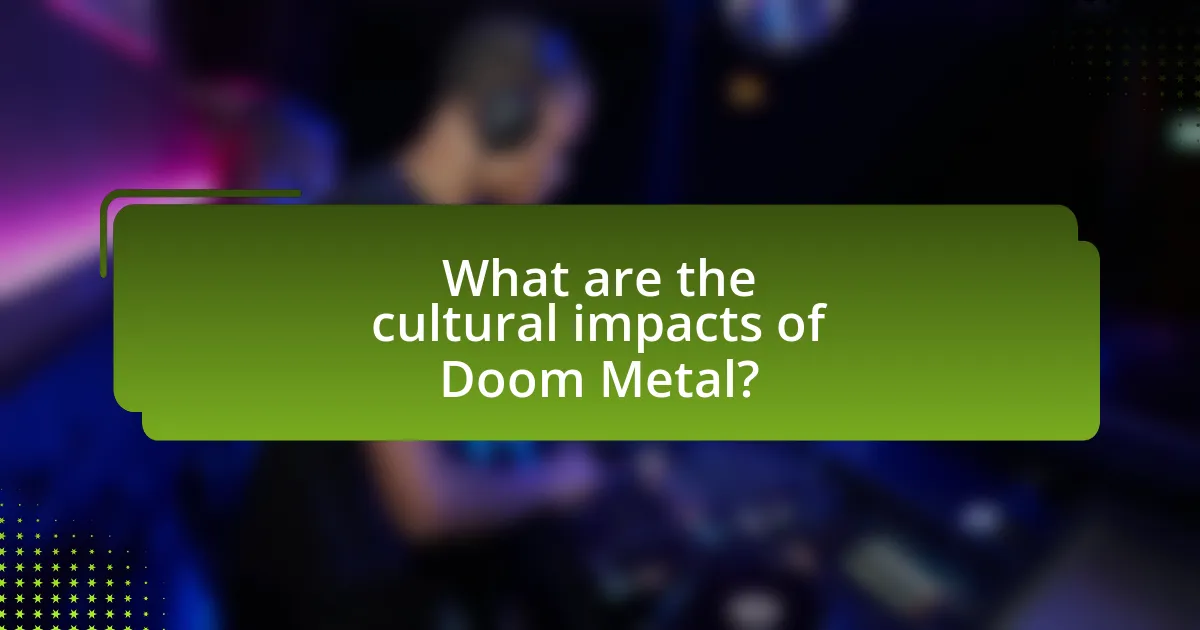
What are the cultural impacts of Doom Metal?
Doom Metal has significantly influenced various cultural aspects, particularly in music, fashion, and community identity. The genre’s slow tempos and heavy riffs have inspired a distinct subculture that values themes of despair, existentialism, and the occult, which resonate in the lyrical content and visual aesthetics of the music. Bands like Black Sabbath, often credited as pioneers of Doom Metal, have shaped the genre’s identity and its cultural narratives since the late 1960s, leading to the emergence of festivals dedicated to the genre, such as the Doom Metal Festival in London. Furthermore, Doom Metal has fostered a sense of community among fans, promoting inclusivity and shared experiences through live performances and online forums, which has been documented in various music studies highlighting the social dynamics within metal subcultures.
How has Doom Metal influenced other music genres?
Doom Metal has significantly influenced various music genres, particularly stoner rock, sludge metal, and even elements of gothic and progressive rock. The slow tempos, heavy riffs, and dark themes characteristic of Doom Metal have been adopted by stoner rock bands like Sleep and Electric Wizard, who incorporate similar heaviness and psychedelic elements. Additionally, sludge metal, exemplified by bands such as Crowbar and Eyehategod, merges the slow, heavy aspects of Doom with hardcore punk, creating a unique sound that retains Doom’s influence. Furthermore, the atmospheric and melancholic elements of Doom have permeated gothic rock, with bands like Paradise Lost integrating its stylistic features into their music. This cross-genre influence demonstrates Doom Metal’s foundational role in shaping the sound and aesthetic of multiple music styles.
What are the cross-genre collaborations seen in Doom Metal?
Cross-genre collaborations in Doom Metal often include elements from genres such as Stoner Rock, Sludge Metal, and even Gothic and Progressive Rock. Notable examples include the collaboration between the band Electric Wizard and various artists from the Stoner Rock scene, which blends heavy riffs with psychedelic elements. Additionally, the band My Dying Bride incorporates orchestral and Gothic influences, showcasing a fusion of Doom Metal with classical music. Another significant collaboration is between the band Crowbar and elements of Hardcore Punk, which adds a raw intensity to their sound. These collaborations highlight the versatility of Doom Metal and its ability to merge with different musical styles, enriching the genre’s overall landscape.
How has Doom Metal shaped the metal community?
Doom Metal has significantly shaped the metal community by introducing a slower, heavier sound that emphasizes atmosphere and emotional depth. This subgenre has influenced various metal styles, encouraging bands to explore themes of despair, existentialism, and the human condition, which has broadened the lyrical and musical scope of metal as a whole. Pioneering bands like Black Sabbath and Pentagram laid the groundwork for Doom Metal in the late 1960s and early 1970s, establishing a template that many subsequent bands have followed. The emergence of subgenres such as Stoner Doom and Funeral Doom further illustrates Doom Metal’s impact, as these styles have carved out dedicated fanbases and festivals, fostering a sense of community among listeners and musicians alike. Additionally, the revival of Doom Metal in the 2000s, with bands like Electric Wizard and Sleep, has led to a resurgence of interest in heavy, riff-driven music, reinforcing its lasting influence on the broader metal genre.
What is the global reach of Doom Metal?
Doom Metal has a significant global reach, with active scenes in Europe, North America, South America, and Asia. The genre originated in the late 1960s and early 1970s, primarily influenced by bands like Black Sabbath, and has since evolved into a diverse subculture. Countries such as the United Kingdom, Sweden, and the United States are known for their prominent Doom Metal bands and festivals, showcasing the genre’s international appeal. For instance, the Roadburn Festival in the Netherlands features numerous Doom Metal acts, attracting fans from around the world. Additionally, the proliferation of online platforms and social media has facilitated the global exchange of music, allowing Doom Metal to reach audiences in countries like Brazil, Japan, and Finland, further solidifying its worldwide presence.
How do different cultures interpret Doom Metal?
Different cultures interpret Doom Metal through their unique historical, social, and musical contexts. For instance, in the United States, Doom Metal often reflects themes of despair and existentialism, influenced by the socio-economic struggles of the working class, as seen in the lyrics of bands like Sleep and Electric Wizard. In contrast, European interpretations, particularly in countries like Sweden and Finland, incorporate elements of folklore and mythology, with bands such as Candlemass and Swallow the Sun drawing on local legends and landscapes to create a sense of place and identity. Additionally, in South America, Doom Metal may intertwine with local rhythms and cultural narratives, as exemplified by bands like Hermética in Argentina, which blend traditional themes with the genre’s heavy sound. These cultural interpretations highlight how Doom Metal serves as a medium for expressing diverse emotional and societal experiences across different regions.
What are some international Doom Metal festivals?
Some international Doom Metal festivals include Roadburn Festival in the Netherlands, Maryland Doom Fest in the United States, and Desertfest, which takes place in multiple locations including London and Berlin. Roadburn Festival, known for its diverse lineup and focus on underground music, has been a prominent event since 1999. Maryland Doom Fest, established in 2015, specifically celebrates the Doom Metal genre and features a range of bands from around the world. Desertfest, originating in London in 2012, has expanded to include events in Berlin and Antwerp, showcasing both established and emerging Doom Metal acts.
What are some tips for exploring Doom Metal?
To explore Doom Metal effectively, start by listening to foundational bands such as Black Sabbath, Pentagram, and Candlemass, as they significantly shaped the genre. Engaging with their albums provides insight into the characteristic slow tempos, heavy riffs, and dark themes that define Doom Metal. Additionally, attending live shows or festivals featuring Doom Metal acts can enhance your understanding of the genre’s atmosphere and community. Exploring subgenres like Funeral Doom and Stoner Doom will also broaden your perspective, as each subgenre offers unique elements while maintaining the core characteristics of Doom Metal.
How can newcomers find the best Doom Metal albums?
Newcomers can find the best Doom Metal albums by exploring curated lists from reputable music websites and engaging with online communities dedicated to the genre. Websites like Metal Archives and RateYourMusic provide extensive databases and user-generated rankings that highlight influential albums. Additionally, platforms such as Spotify and Apple Music often feature playlists that showcase essential Doom Metal tracks, helping listeners discover key artists and albums. Engaging with forums like Reddit’s r/DoomMetal allows newcomers to seek recommendations from seasoned fans, ensuring they access both classic and contemporary releases that define the genre.
What are essential live performances to experience in Doom Metal?
Essential live performances to experience in Doom Metal include events featuring iconic bands such as Black Sabbath, Candlemass, and Electric Wizard. Black Sabbath’s performance at the 1970 Isle of Wight Festival is historically significant, as it showcased the band’s pioneering sound that defined the genre. Candlemass’s live album “Live” captures their powerful stage presence and is a must-see for fans, while Electric Wizard’s performances are known for their heavy, immersive atmosphere, particularly at festivals like Roadburn. These performances exemplify the essence of Doom Metal, characterized by slow tempos, heavy riffs, and a dark, brooding aesthetic.

